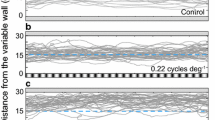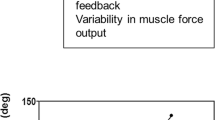Abstract
A test paradigm is designed to determine which features of viewed objects (a disk 10° in diameter) are responsible for preferential fixation by Colorado beetles (Leptinotarsa decemlineata). The beetle walks on a locomotion compensator that permits free choice of direction in a visual surround containing three different objects. The beetles use both colour and contrast information in these choice experiments. The preferred colours are yellow and orange; their attractiveness is considerably enhanced when they appear in a pattern with highly contrasting features such as stripes. In its “optimal” form, the object amounts to a dummy beetle, with a pattern that resembles the markings on the elytra of this species. Since the beetles appear to employ a contact pheromone for sex recognition, the function of orientation to these patterns is unclear. However, the patterns might accelerate the identification of conspecifics or be effective at a distance. The reaction to the dummies is telotactic — that is, the beetles walk towards the dummy. One other object, a 10°-wide black stripe, elicits menotactic orientation, in which the beetle maintains a stable course at an angle to the object.
Similar content being viewed by others
References
Batschelet E (1981) Circular statistics in biology. Academic Press, New York
Franceschini N (1975) Sampling of the visual environment by the compound eye of the fly: fundamentals and applications. In: Snyder AW, Menzel R (eds) Photoreceptor optics. Springer, Heidelberg, pp 98–125
Frisch K von (1965) Tanzsprache und Orientierung der Bienen. Springer, Berlin Heidelberg New York
Götz KG (1964) Optomotorische Untersuchung des visuellen Systems einiger Augenmutanten der Fruchtfliege Drosophila. Kybernetik 2:77–92
Hertz M (1934) Zur Physiologie des Formenund Bewegungssehens. III. Figurale Unterscheidung und reziproke Dressuren bei der Biene. Z Vergl Physiol 21:604–615
Kirschfeld K (1973) Das neuronale Superpositionsauge. Fortschr Zool 21:229–257
Kirschfeld K (1976) The resolution of lens and compound eyes. In: Zettler F, Weiler R (eds) Neural principles in vision. Springer, Heidelberg, pp 354–370
Levinson HZ, Levinson AR, Jen T-L (1979) Sex recognition by a pheromone in the Colorado beetle. Naturwissenschaften 66:472–473
Lönnendonker U (1984) Der Beitrag von Fixation und Optomotorik an der Orientierung laufender Kartoffelkäfer. Statische und dynamische Aspekte beider Systeme. Dissertation, Univ Köln
Lönnendonker U (1991a) Dynamic properties of orientation to a visually fixated target by walking Colorado beetles. J Exp Biol 158:149–164
Lönnendonker U (1991b) Optomotor response and fixation of walking Colorado beetles (Coleoptera: Chrysomelidae): Course control aspects. J Insect Behav 4:347–365
Lönnendonker U, Scharstein H (1991) Fixation and optomotor response of walking Colorado beetles: Interaction with spontaneous turning tendencies. Physiol Entomol 16:65–70
Mischke U (1981) Spektrale Eigenschaften des visuellen Systems von Leptinotarsa decemlineata (Coleoptera: Chrysomelidae). Zool Beitr NF 27:319–334
Stüben M (1972) Untersuchungen zum Farbwahlvermögen des Kartoffelkäfers Leptinotarsa decemlineata Say. Nachrichtenbl Deutsch Pflanzenschutzdienst 24:40–41
Wachman E (1977) Vergleichende Analyse der feinstmkturellen Organisation offener Rhabdome in den Augen der Cucujiformia (Insecta, Coleoptera), unter besonderer Berücksichtigung der Chrysomelidae. Zoomorphologie 88:95–131
Weber T, Thorson J, Huber F (1981) Auditory behaviour of the cricket. I. Dynamics of compensated walking and discrimination paradigms on the Kramer treadmill. J Comp Physiol 141:215–232
Wehner R (1981) Spatial vision in arthropods. In: Autrum H (ed) Handbook of sensory physiology. Vol VII/6C. Springer, Berlin Heidelberg New York, pp 287–616
Wolf E (1934) Das Verhalten der Bienen gegenüber flimmernden Feldern und bewegten Objekten. Z Vergl Physiol 20:151–161
Zerrahn G (1934) Formdressur und Formunterscheidung bei der Honigbiene. Z Vergl Physiol 20:117–150
Author information
Authors and Affiliations
Rights and permissions
About this article
Cite this article
Lönnendonker, U. Features effective in course control during object fixation by walking Colorado beetles. J Comp Physiol A 172, 741–747 (1993). https://doi.org/10.1007/BF00195399
Accepted:
Issue Date:
DOI: https://doi.org/10.1007/BF00195399




